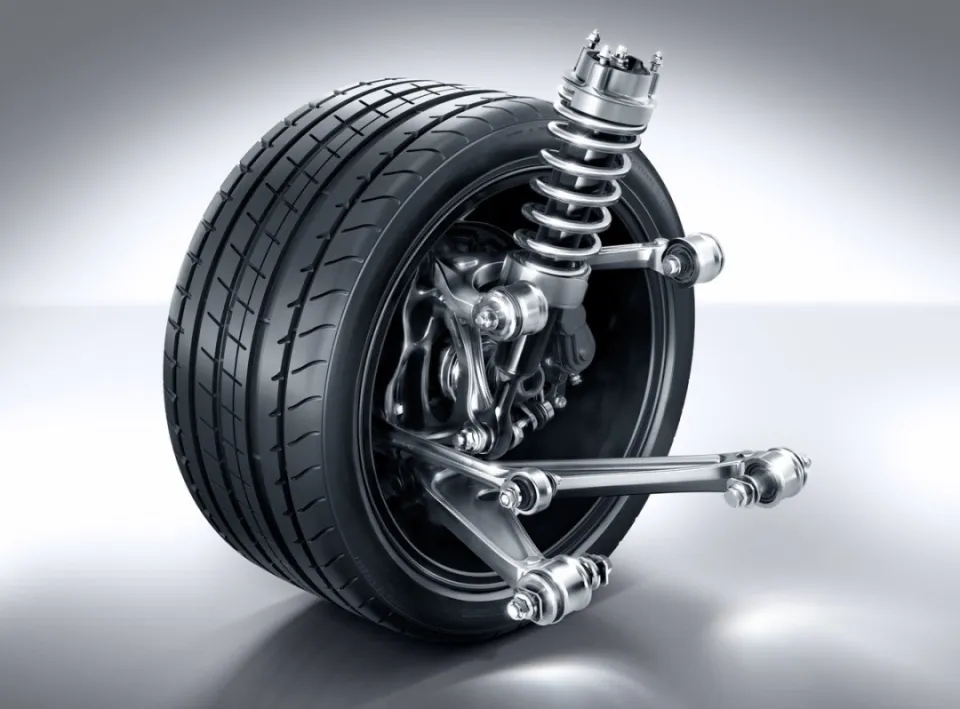Suspension: the "connecting link" between the body and the wheels
Automotive suspension is a critical system that connects the body and wheels, with its core mission being to transmit force and torque, cushion road impacts, and maintain vehicle stability during operation. Although the structure of the suspension may seem complex, it mainly consists of three core components: elastic elements, shock absorbers (dampers), and guiding mechanisms, as well as some auxiliary components to enhance overall performance.
Three core components: the "three carriages" of suspension
Elastic element: the "backbone" of buffering
The elastic element is the buffering core of the suspension, mainly responsible for absorbing impact energy from the road surface and supporting the vertical load of the vehicle. Common elastic components include coil springs, torsion bar springs, air springs, etc. Although they come in different forms, their core function is to provide elastic support and cushioning.

Shock Absorber (Damper): A Stable 'Guardian'
The function of shock absorbers is to suppress the continuous shaking of the vehicle caused by road bumps. It converts the energy generated during the compression and rebound of elastic components into thermal energy and dissipates it through hydraulic or electromagnetic means. If there were no shock absorbers, the vehicle would continuously bounce up and down like a trampoline when encountering bumps, and shock absorbers are the key component that "pulls" the body and restores stability.
Guiding mechanism: the "commander" of the movement
The guiding mechanism is responsible for accurately controlling the motion trajectory of the wheels relative to the vehicle body, such as controlling the changes in camber angle and toe angle when the wheels bounce up and down, and transmitting longitudinal (driving/braking) and lateral (turning) forces. Guidance mechanisms are usually composed of various linkages and swing arms, with common structures including single wishbone, double wishbone (double wishbone), and multi linkage. Different structural layouts directly affect the handling stability and comfort performance of vehicles.
Auxiliary components: "bonus points" for performance
Lateral stabilizer bar (anti roll bar): a "balance hand" for anti roll
The main function of the stabilizer bar is to reduce the body roll of the vehicle when turning. It utilizes its own torsional stiffness to generate reactive forces when the left and right wheels move unevenly, balancing the movements on both sides and improving the vehicle's handling stability.
Buffer block: the "security guard" of extreme protection“
The function of the buffer block is to prevent hard collisions between metal components (such as the swing arm and the frame) when the suspension stroke reaches its limit (such as encountering a large pit), and to protect the suspension structure from component damage caused by excessive impact.
Technological Evolution: The Evolution Path of Suspension“
Early suspension: rudimentary starting point
The starting point of suspension technology can be traced back to the era of horse drawn carriages. Early car suspensions were very rudimentary, such as the 1886 Mercedes Benz One, where the wheels were directly connected to the body through rigid axles, with almost no cushioning and a strong sense of jolting. The 1908 Ford Model T adopted a non independent steel plate spring suspension, which, although structurally simple and cost-effective, had poor comfort and could only adapt to rough road conditions at the time.
The birth of independent suspension: technological breakthrough
In 1922, the Italian Blue Flag Lambda became the world's first mass-produced car equipped with front wheel independent suspension, solving the problem of "left and right wheel linkage bumps" caused by non independent suspension. In 1931, the Mercedes Benz 170 became the first model to be equipped with four-wheel independent suspension, with a double wishbone front suspension and a swing axle rear suspension design, greatly reducing the bumpy feeling on gravel roads. However, the high manufacturing cost limited it to luxury models.
The foundation of classic structure: the maturity of technology
In 1982, the Audi 80 adopted a trailing arm independent rear suspension, which connected the wheels to the subframe through a single longitudinal arm, significantly reducing space occupation. In 1994, the five link independent rear suspension of the Mercedes Benz W210 E-Class became the pinnacle of rear suspension technology. The five link precisely controls the six degrees of freedom of the wheels, significantly improving shock absorption efficiency. However, the structure is complex and the maintenance cost is high.

The evolution of elastic elements and shock absorbers: from passive to active
Early elastic components were mainly mechanical springs (such as coil springs, steel plate springs, torsion bar springs). In 1957, Cadillac Eldorado Brougham became the first passenger car to be equipped with air suspension, but the early system response was slow and the failure rate was high. In 2003, Cadillac CTS's CDC (Continuous Damping Control) and Corvette Z06's MRC (Magnetorheological Shock Absorber) brought the suspension into the era of "millisecond level response", significantly improving the vehicle's handling and comfort.
System integration and revolution: a leap towards intelligence
In 2018, Audi A8 launched the first predictive active suspension. The front camera can predict the road turbulence in advance and adjust the suspension parameters in advance. In 2020, the Mercedes Benz S-Class's "Magic Carpet Suspension 2.0" integrated a 48V system, scanned the road surface with a laser radar, and adjusted the damping 1000 times per second, with the goal of achieving "zero impact" passing through speed bumps. In 2024, the Porsche Panamera's Active Ride system will use hydraulic pumps and dual external valves to independently control each shock absorber, eliminating traditional anti roll bars and providing extremely fast response times. In 2025, the NIO ET9's "Tianxing" fully active suspension system will have functions such as early wheel lifting, restraining nodding, and actively pulling down the front of the car, enhancing the driving experience in all aspects.
From Passive to Active, from Reaction to Prediction: The Future of Suspension Technology
The development of suspension technology has gone through a transition from passive bearing of bumps to active resolution of impacts, and then to intelligent prediction of road conditions. Early suspensions were purely mechanical structures that could only passively respond to impacts on the chassis. With the development of electronic control technology, the suspension can sense the vehicle's state through sensors and actively adjust damping or height, resulting in continuously improving response speed. Now, using environment sensing sensors (such as laser radar, millimeter wave radar, camera), the suspension can predict the road condition in advance, adjust parameters before the wheels encounter impact, and achieve true "bumpiness prevention".
From its inception to the present, every technological breakthrough in automotive suspension has profoundly changed people's driving experience. In the future, with the continuous advancement of intelligent and electric technology, suspension technology will continue to evolve, providing users with a more comfortable, stable, and intelligent driving experience.

